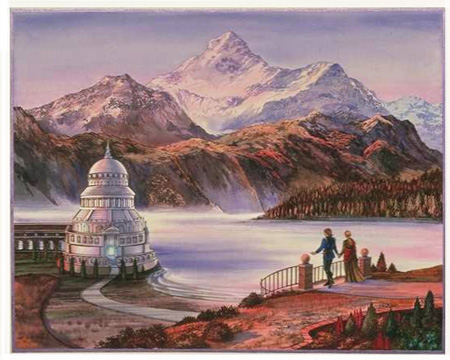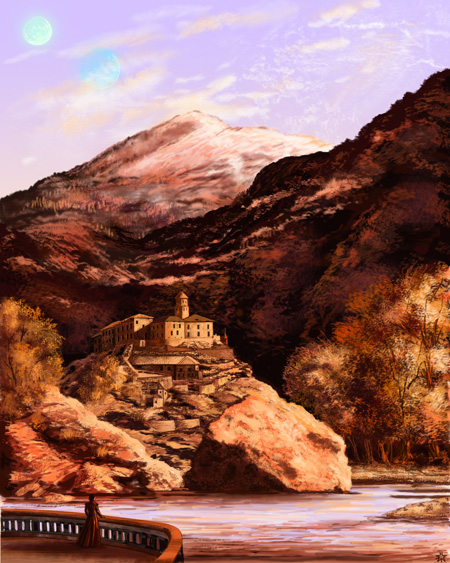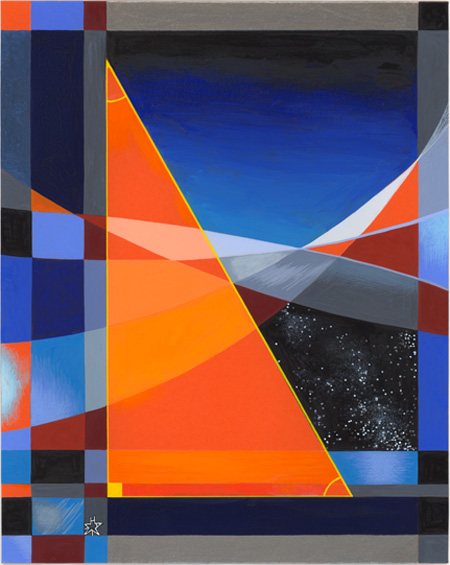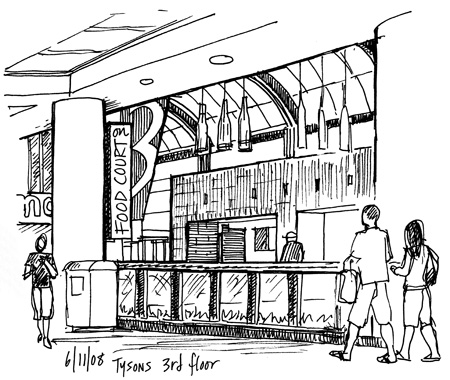My weblog ELECTRON BLUE, which concentrated on science and mathematics, ran from 2004-2008. It is no longer being updated. My current blog, which is more art-related, is here.
Tue, 24 Jun, 2008
Darkover in Photoshop
I just completed my first full-scale "painting" in Photoshop. I have been working with this digital medium for more than a year but I have not created any "finished" art with it. Now that I know enough to simulate painting technique with the program, I decided to do a piece which refers back to my fantasy landscapes and architecture of the 80s and 90s, when I was a professional fantasy/science fiction illustrator.
During those years, I was the unofficial "house illustrator" for the fans of Marion Zimmer Bradley, a pioneering female fantasy author. One of her imaginary worlds was that of "Darkover," a far-off planet orbiting a red sun. The Darkover tales were a mixture of swashbuckling, magic, and social experimentation, written by Bradley by herself or with collaborators from the late 60s until her death in 1999. I did numerous character portraits, scenes, and landscapes from the World of the Red Sun.
In 1990 I did a fantasy landscape as a commission for a Darkover-fan friend. This was "The Mausoleum at Hali," a fantastic structure which sat at the edge of a mountain lake which was not made of water, but of mist. It is watercolor on board, 16" x 20".

With this picture in mind, I set out to create a similar scene in Photoshop. I used a picture of a northern Italian mountain castle as a reference. I drew directly to the computer, using my Wacom drawing tablet with no previously scanned pencil drawing. Each section of the picture, from mountains to castle to lake (this time it is water, not mist) to foreground balcony, was done in separate "layers," which are work areas that don't mix with each other until you need them to. This is something that of course cannot be done in conventional media.
Photoshop uses what might be called "pixel spreaders" instead of actual fiber brushes. It adds color into the microscopic grains of the screen, using light instead of pigment. These "pixel spreaders" are usually simply called "brushes" in Photoshop. The possibilities for these Photoshop brushes are endless; you can create your own or modify ones that come with the program. For landscaping, there are very convenient "brushes" which slightly randomize your stroke so that you can paint the irregularities of rock or cloud or wood. And there are other brushes which "spray" or "spatter" dots in more "randomized" patterns to resemble tree leaves. I used all these digital tricks to recreate the "natural" textures I saw in the photograph.
Interestingly, though Photoshop picture creation seems easier than conventional painting even to the point of "cheating," I spent about the same amount of time doing the Photoshop work as I did the original watercolor: a week or so, working about 3 hours each night. It's possible that I will be able to work faster as I get more proficient in Photoshop. After all, one of the things which make conventional work go slower for me is that I have to wait for paint to dry in order to put the next area on. In Photoshop, everything you do is ready to work on as soon as you have placed it.
So here's my tribute to Darkover and the World of the Red Sun, done in Photoshop rather than watercolor. Dimensions are 20" x 16".

For a larger version of this image, please click here.
Posted at 3:52 am | link
Sat, 21 Jun, 2008
Thirty Sixty Ninety
You may be wondering why I have been posting so infrequently to the Electron recently. This lack of blogification is due to increased time allotted to painting and drawing. Even doing an only part time day job, I just don't have enough time in a day to do all the tasks I need to do. So there has been less action here while I get things done. But when I finally have something important done, it goes here.
I just finished another geometric abstraction painting. These pictures, for some reason I don't quite understand, are popular, not only among my friends but among gallery-goers and convention viewers. People whom I would expect to be much more conservative in their taste appreciate these abstractions. It's fascinating to me. Paintings like these, which have no human images and little or no sentiment or emotion, would have been avant-garde 100 years ago. Now they are accepted in non-avant-garde situations. I wonder if this is a sign of progress, or just change. Art followers get used to things. This is good for me, because I am not an avant-garde artist and have no desire to shock or disturb people in the name of art. That's bad for business.
The name of this painting is "30-60-90" which refers to the angles in a trigonometrically significant triangle. It's depicted in bright orange here. I was reviewing trigonometry at the time I designed it. For trigonometry fans, you remember that the ratio of the three sides of this triangle are: shortest side = 1, next longest side = square root of 3 (about 1.732) and the hypotenuse = 2. This has been true as long as our universe has existed.
Acrylic on thick orange paper, 10" x 8".

Posted at 4:09 am | link
Thu, 12 Jun, 2008
The Mall as an Imaginary Prison
I haven't done any mall drawings for a while so I went into Tysonia after work to get some grub (mall food) and do some art. I ate and drew in the same place, the food court whose sign you see in this picture. This food court is in the newest part of the vast shopping complex. Finding a good place to draw in a crowded mall is hard to do, and the food court tables serve the purpose well.

Architecturally, the new part of the mall doesn't quite match the older part. There is a lot of stone and hard surfaced material, including the central structure you see in the picture, which is made of blocks of what looks like highly polished granite. The geometry is harder and more angular, and the colors harsher. The skylight vault is built with dark metal archways and leaded windows. Some of the light is provided by hanging glass cylinders shaped rather like elongated bottles or perhaps artillery shells.
The scene I drew reminded me not of a playful profit-making place of buying and selling, but of one of Piranesi's famous Imaginary Prisons architectural fantasies. The grim stone, the massive piers, the archways, and the suspended catwalks complete with metal balconies had been transposed to the early twentieth century commercial world. In this unwitting imaginary prison, the weekday consumers wandered about, clad in shorts and soft T-shirts and flip flop sandals, as if they had just come in from the beach. Also, because of the hard reflectivity of the surfaces, the mall was very noisy. A screaming baby would fill the space with echoes; the rock and hip hop soundtrack made sure that the decibel level stayed high.
I'm not trying to condemn anything in a supercilious way. I'm a consumer, too. I enjoy the colored lights and windows full of goods. I like people-watching. I like eating greasy mall food. Malls and bazaars have always been noisy and full of action. It's just that because I know and love Piranesi's work, I saw something in the structure of the mall that showed me an unexpected architectural shadow.
Posted at 3:25 am | link
Wed, 04 Jun, 2008
Aliens among us
Many years ago, science fiction author C.J. Cherryh wrote a short novel about a society established by human colonists on a distant planet that was already inhabited by sentient aliens. The human colonists, rather than slaughtering them, simply lived side-by-side with the natives, and convinced themselves that the natives just didn't exist. The humans trained themselves to completely ignore the alien beings who lived their lives among them. The book was called Wave Without a Shore, published in 1981 by DAW Books and now long out of print.
Living in the crowded urbanization of Northern Virginia reminds me of this story. I live in a world that is filled with aliens, beings who don't talk my language and who I never interact with. Yet they live next door to me, down the hall, and all over the apartment complex. They are from Mexico, Central America, and South America, and there are, in the Metro DC area, hundreds of thousands of them. I see them, and yet I don't see them.
Some of them are here legally, many others, indistinguishable from the first group, are not. Most of them are men between the ages of 18 and 40, short, stocky brown men with high Indio cheekbones and Asian eyes. They wear dull-colored sports garb and backwards baseball caps, and they smoke a lot. In the summer, they wear tank tops, board shorts, and keep the backwards baseball cap. They don't speak any English, and they are not well educated. I am not sure whether they can read and write; no one keeps statistics on this.
You do not try to talk to these folk. They are suspicious and will turn away. Looking at them, especially looking them in the eyes, is very impolite in their culture. Even if I knew Spanish fluently, it would not be easy to have a conversation with them, since they speak local or rural dialects interspersed with Indian and slang words. And they don't want to talk to outsiders, because outsiders could turn them in. They also are not aggressive to outsiders or dangerous (that is, to white or black Americans), because since they are here illegally, the last thing they want is to be arrested for some crime and found to have false identification papers.
Why are they here? Because they can get work here, and back in Guatemala or Mexico, they can't. It doesn't matter how poorly this work pays, it is better than nothing. They work in landscaping, cleaning, construction, hard dirty outdoor work that doesn't require a lot of training or education to do. The women who make the journey work as nannies, maids, or office cleaners. Some of them are legally employed, others are not. If they are illegal immigrants, there is no law that will protect them against employers who pay them less than minimum wage. They work day after day with no restrictions or legal protection, just as they have done down in New Orleans rebuilding after the hurricane. And even so, I see them at the post office day after day, paying cash (sometimes gained "under the table") for money orders to pay their bills and rent and to send home to their relatives in the old country. I imagine that there are towns and villages in Central America where there are no people left but old men, a few older women, and children.
These invisible folk share our resources and our urban lives without any interaction. They use apartments in my building, sleeping on the floors of rooms rented from legal immigrants who pay the rent to the landlords. They use the laundry rooms, and park their vehicles in the parking lot. There are times when I never see the same person twice in our hallways. They are here today, gaining an ephemeral address so that they can claim a residence when they search for work, and then they are gone tomorrow. It is an endless flow of lives, none of which I will ever know. I won't know their sorrows or their joys or their families. They are shadows in the hallway, creatures in the back yard armed with hedge clippers or weed-whackers or air blowers, appearing once and never again. It is like some of those "magical realist" books written by the intellectual upper-class of those same Latin American countries: people who fill the world but who might not exist.
In the modern world, they live electronically. They may be impoverished illegal aliens, but they all have cell phones that someone pays for. Their group apartments and homes have satellite dishes so they can watch TV from the old country and their soccer games. They may even have internet access, though I have no way to find out. The shadows in the hall have a virtual life independent of their toiling existence here.
In writing this, I am perhaps transgressing the non-political nature of this Weblog. Social comment is not what ELECTRON BLUE is all about. I am not advocating any position on illegal immigration. It is just part of my world here in the city, a feature of the layered reality where virtual characters, mathematical axioms, and illegal aliens coexist without colliding with each other; a world of people as particles of dark and light matter, hidden and open, real and imaginary.
Posted at 3:19 am | link
